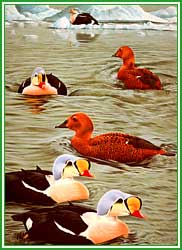|
Birds of America by John James Audubon THE KING DUCK.
[King Eider.] FULIGULA SPECTABILIS, Linn. [Somateria spectabilis.]
http://employeeweb.myxa.com/rrb/Audubon/VolVI/00669.html
 Breeding Biology Of King
Eiders Nesting On Karrak Lake, N.W.T. KELLETT, DANA K. Department of
Biology, University of Saskatchewan, 112 Science Place, Saskatoon,
Saskatchewan, Canada S7N 5E2 ALISAUSKAS, RAY T. Prairie and Northern
Wildlife Research Centre, Canadian Wildlife Service, 115 Perimeter Road,
Saskatoon, Saskatchewan, Canada S7N 0X4 We studied various aspects of the
breeding biology of king eiders (Somateria spectabilis) nesting at Karrak
Lake, south of Queen Maud Gulf in the central Canadian Arctic. We found 41
nests distributed among 10 islands in Karrak Lake; to our knowledge, this
represents the largest number of king eider nests studied at one site. We
suspect that island-nesting by king eiders is more common than has been
previously reported. King eiders favoured mid-sized islands (0.002 - 0.081
km?) favoured over very small (<0.002 km?) or very large (>0.081
km?) islands. Mean clutch size was 5.4 Ò 1.7 (SD) eggs. Apparent nest
success was 69.4%, with a composite Mayfield estimate of nest success over
egg laying and incubation of 48.7% (95% CI: 47.4 - 50.0%). Nest success
was uncorrelated with date of nest initiation or island size, but eiders
nesting on islands farther from the mainland had increased success over
those nesting on islands closer to the mainland. Additionally, nest
success was greater on islands with more nesting eiders and on islands
with nesting arctic terns (Sterna paradisaea). Breeding Biology Of King
Eiders Nesting On Karrak Lake, N.W.T. KELLETT, DANA K. Department of
Biology, University of Saskatchewan, 112 Science Place, Saskatoon,
Saskatchewan, Canada S7N 5E2 ALISAUSKAS, RAY T. Prairie and Northern
Wildlife Research Centre, Canadian Wildlife Service, 115 Perimeter Road,
Saskatoon, Saskatchewan, Canada S7N 0X4 We studied various aspects of the
breeding biology of king eiders (Somateria spectabilis) nesting at Karrak
Lake, south of Queen Maud Gulf in the central Canadian Arctic. We found 41
nests distributed among 10 islands in Karrak Lake; to our knowledge, this
represents the largest number of king eider nests studied at one site. We
suspect that island-nesting by king eiders is more common than has been
previously reported. King eiders favoured mid-sized islands (0.002 - 0.081
km?) favoured over very small (<0.002 km?) or very large (>0.081
km?) islands. Mean clutch size was 5.4 Ò 1.7 (SD) eggs. Apparent nest
success was 69.4%, with a composite Mayfield estimate of nest success over
egg laying and incubation of 48.7% (95% CI: 47.4 - 50.0%). Nest success
was uncorrelated with date of nest initiation or island size, but eiders
nesting on islands farther from the mainland had increased success over
those nesting on islands closer to the mainland. Additionally, nest
success was greater on islands with more nesting eiders and on islands
with nesting arctic terns (Sterna paradisaea). |
